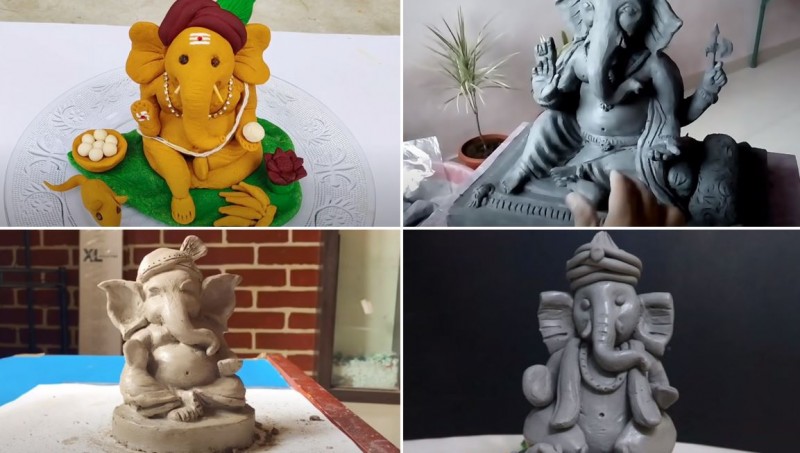
Ganesh Chaturthi, also known as Ganeshotsav, is a significant Hindu festival celebrated with great enthusiasm in India and by Hindus worldwide. It marks the birth of Lord Ganesha, the elephant-headed god of wisdom and prosperity. During this ten-day festival, devotees install Ganesha idols in their homes and community pandals, offer prayers, and immerse the idols in water bodies to bid farewell to the deity. In recent years, there has been a growing awareness of the environmental impact of using plaster of Paris (PoP) idols for these celebrations. PoP idols do not dissolve easily and often pollute water bodies, harming aquatic life. To address this concern, many people are now turning to eco-friendly alternatives, such as clay or mitti idols, which are biodegradable and less harmful to the environment.
In this article, we will guide you through the process of making an eco-friendly Ganesha idol at home using clay or mitti. This DIY approach not only allows you to connect with the festival on a deeper level but also contributes to a cleaner and greener environment.
Materials Needed
Before you start creating your eco-friendly Ganesha idol, gather the following materials:
Clay or Mitti: You will need a lump of clay or mitti, which is readily available in local markets or craft stores.
Rolling Pin: A rolling pin is essential for flattening and shaping the clay.
Knife or Cutter: You'll need a knife or cutter to cut the clay into specific shapes.
Water: Keep a bowl of water handy for smoothing the clay and joining different parts of the idol.
Scale: A scale will help you measure and shape various elements of the idol.
Pencil: A pencil can be used to sketch the initial outline of the idol on the clay.
Colored Powders or Paint (optional): If you want to add colors to your Ganesha idol, have some eco-friendly colored powders or paints ready.
Step-by-Step Guide to Making an Eco-Friendly Ganesha Idol
Follow these steps to create your own eco-friendly Ganesha idol at home:
Preparation:
Begin by selecting a clean and clutter-free workspace, preferably covered with plastic sheets or newspapers to prevent any mess.
Ensure that your hands and tools are clean to avoid contaminating the clay.
Knead the Clay:
Take a lump of clay and knead it thoroughly to make it soft and pliable. This will make it easier to work with.
Create the Base:
Divide the clay into four equal parts and take one of them as the base.
Flatten the clay using a rolling pin to create a flat, circular base. This will serve as the foundation for your Ganesha idol.
Build the Body:
Take another portion of clay and shape it into a round ball. This will be the main body of Lord Ganesha.
Attach the body to the base by applying a small amount of water at the point of contact and gently pressing the two pieces together. Ensure a secure connection.
Form the Limbs:
To create the limbs (arms and legs), roll out four long cylindrical shapes from the remaining two portions of clay. These will be the arms and legs of Ganesha.
Attach the limbs to the body by gently pressing them into place. Use water to smooth the connections and ensure they are firmly attached.
Shape the Head:
For the head, take a small portion of clay and shape it into a slightly flattened sphere.
Attach the head to the body using the same method as with the limbs. Ensure that the head is securely fixed atop the body.
Add Details:
Use a knife or cutter to add details to your Ganesha idol. You can create features like the trunk, ears, and decorative ornaments.
Be creative with the details, and refer to images or idols for reference if needed.
Create the Garland:
To make the garland, roll out a thin strip of clay and shape it into a circular or semi-circular form.
Attach the garland around Ganesha's neck.
Decorate:
If you wish to add colors to your idol, use eco-friendly colored powders or paints. Ensure that the colors are non-toxic and safe for the environment.
Let it Dry:
Allow your Ganesha idol to air dry completely. This may take a few days, depending on the size and thickness of the idol.
Pooja and Prayers:
Once your eco-friendly Ganesha idol is dry, perform a traditional pooja (worship) and offer prayers to invoke the divine blessings of Lord Ganesha.
Immersion:
After the conclusion of Ganesh Chaturthi, you can immerse your clay idol in a bucket of water at home. The idol will dissolve over time, and the water can be used for gardening or other eco-friendly purposes.
Making your own eco-friendly Ganesha idol at home is not only a creative and meaningful way to celebrate Ganesh Chaturthi but also a responsible choice that contributes to environmental sustainability. By choosing clay or mitti idols over plaster of Paris, you can enjoy the festival while minimizing its ecological impact. Remember that the process of creating a Ganesha idol can be a joyful and spiritual experience, and you can involve family members or friends to make it even more special. This eco-conscious approach not only honors tradition but also aligns with the principles of environmental conservation, making your celebration of Ganesh Chaturthi truly blessed and harmonious with nature.
Don't make a fool of yourself! Understand the traditions of the nations you visit
At what time does worship not yield results? On the contrary, we become partners of the sinner